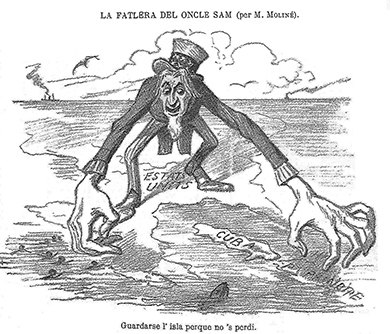| << Chapter < Page | Chapter >> Page > |
The Spanish-American War was the first significant international military conflict for the United States since its war against Mexico in 1846; it came to represent a critical milestone in the country’s development as an empire. Ostensibly about the rights of Cuban rebels to fight for freedom from Spain, the war had, for the United States at least, a far greater importance in the country’s desire to expand its global reach.
The Spanish-American War was notable not only because the United States succeeded in seizing territory from another empire, but also because it caused the global community to recognize that the United States was a formidable military power. In what Secretary of State John Hay called “a splendid little war,” the United States significantly altered the balance of world power, just as the twentieth century began to unfold ( [link] ).

Despite its name, the Spanish-American War had less to do with the foreign affairs between the United States and Spain than Spanish control over Cuba and its possessions in the Far East. Spain had dominated Central and South America since the late fifteenth century. But, by 1890, the only Spanish colonies that had not yet acquired their independence were Cuba and Puerto Rico. On several occasions prior to the war, Cuban independence fighters in the Cuba Libre movement had attempted unsuccessfully to end Spanish control of their lands. In 1895, a similar revolt for independence erupted in Cuba; again, Spanish forces under the command of General Valeriano Weyler repressed the insurrection. Particularly notorious was their policy of re-concentration in which Spanish troops forced rebels from the countryside into military-controlled camps in the cities, where many died from harsh conditions.
As with previous uprisings, Americans were largely sympathetic to the Cuban rebels’ cause, especially as the Spanish response was notably brutal. Evoking the same rhetoric of independence with which they fought the British during the American Revolution, several people quickly rallied to the Cuban fight for freedom. Shippers and other businessmen, particularly in the sugar industry, supported American intervention to safeguard their own interests in the region. Likewise, the “Cuba Libre” movement founded by José Martí , who quickly established offices in New York and Florida, further stirred American interest in the liberation cause. The difference in this uprising, however, was that supporters saw in the renewed U.S. Navy a force that could be a strong ally for Cuba. Additionally, the late 1890s saw the height of yellow journalism , in which newspapers such as the New York Journal , led by William Randolph Hearst, and the New York World , published by Joseph Pulitzer, competed for readership with sensationalistic stories. These publishers, and many others who printed news stories for maximum drama and effect, knew that war would provide sensational copy.

Notification Switch
Would you like to follow the 'U.s. history' conversation and receive update notifications?